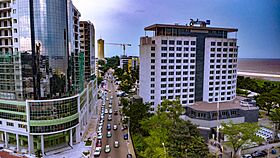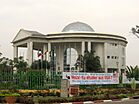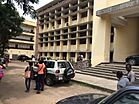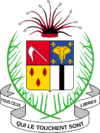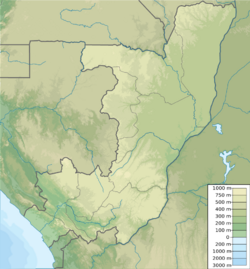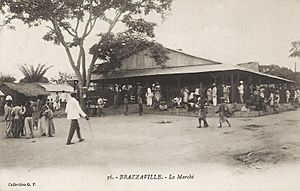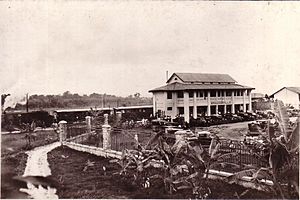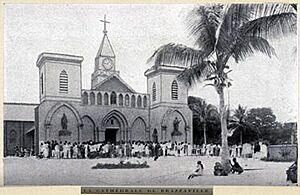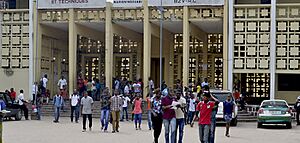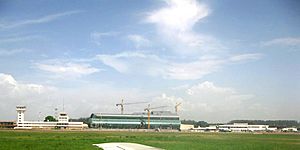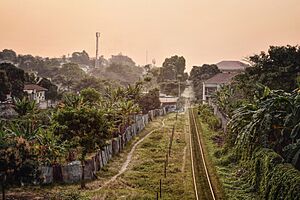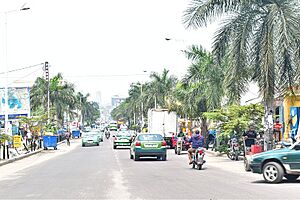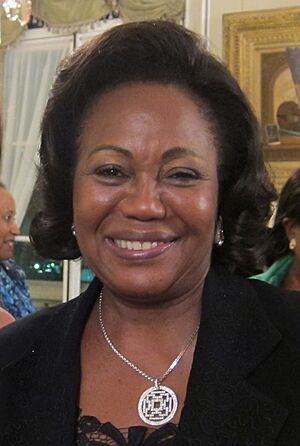Brazzaville facts for kids
Quick facts for kids
Brazzaville
|
||
|---|---|---|
|
Top: Brazzaville Skyline in Amilcar Cabral Avenue; Middle: World Health Organization Office, Congo River; Bottom: Brazza Mausoleum, Marien Ngouabi University
|
||
|
||
| Country | Republic of the Congo | |
| Capital district | Brazzaville | |
| Department | Brazzaville | |
| Commune | Brazzaville | |
| Founded | 1883 | |
| Founded by | Pierre Savorgnan de Brazza | |
| Area | ||
| • Capital city | 588 km2 (227 sq mi) | |
| Elevation | 320 m (1,050 ft) | |
| Population
(2023 census)
|
||
| • Capital city | 2,145,783 | |
| • Density | 3,649.3/km2 (9,452/sq mi) | |
| • Urban | 2,557,100 | |
| • Metro | 2,724,566 | |
| • Official language |
|
|
| • National languages |
|
|
| Demonym(s) | Brazzavillian | |
| Time zone | UTC+01:00 (West Africa Time) | |
| • Summer (DST) | (Not Observed) | |
| Area code(s) | 242 | |
| HDI (2021) | 0.623 · medium · 1st of 12 | |
Brazzaville is the capital and largest city of the Republic of the Congo. It's also a special administrative area, acting as both a department and a commune. This city is the main financial and administrative hub of the country.
It sits on the north side of the Congo River, directly across from Kinshasa, the capital of the Democratic Republic of the Congo. More than 2.1 million people live in Brazzaville, which is over a third of the country's population.
During World War II, Brazzaville was an important place. It served as the temporary capital for Free France from 1940 to 1942. In 2013, UNESCO recognized Brazzaville as a City of Music. It's now part of the Creative Cities Network.
Contents
Exploring Brazzaville's Location
Brazzaville covers a large area north of the Congo River, just below a wide part of the river called the Pool Malebo. Mbamu, a big island in the Pool, belongs to the Republic of the Congo.
The city is about 506 kilometers (314 miles) inland from the Atlantic Ocean. It's also about 474 kilometers (295 miles) south of the equator. Brazzaville is mostly flat and sits at an altitude of about 317 meters (1,040 feet).
Brazzaville and Kinshasa: Two Capitals Across a River
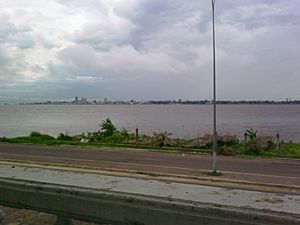
Kinshasa, the capital of the Democratic Republic of the Congo, is right across the Congo River from Brazzaville. To tell the two "Congo" countries apart, the Republic of the Congo is sometimes called Congo-Brazzaville. Kinshasa is much larger than Brazzaville in population.
These two cities are unique. They are the only national capitals in the world that face each other across a river.
Protecting the Congo Basin's Peatlands
In 2018, the "Brazzaville Declaration" was signed. This agreement aims to protect the Cuvette Centrale. This area in the Congo Basin is the world's largest tropical peatland, full of swamp forests.
Saving this area is vital for large animals and for the Earth's climate. If the peat were to burn, it would release a lot of carbon and make the planet warmer. The declaration was signed by the Democratic Republic of the Congo, the Republic of the Congo, and Indonesia.
A Look at Brazzaville's Past
Brazzaville was founded by the French colonial empire. It was built on an existing settlement of the Bateke people called Ncuna. This happened during the "Scramble for Africa," when European countries were claiming parts of the continent.
The city was officially founded on September 10, 1880, by an Italian-born explorer named Pierre Savorgnan de Brazza. He became a French citizen in 1874, and the city is named after him.
Early Days and French Control
The local King, Makoko of the Téké, signed a treaty with Brazza. This agreement placed his lands under French rule. From 1880 to 1882, a small group of soldiers led by Sergeant Malamine Camara stayed at the site. They made sure the land didn't fall into Belgian hands.
The first major buildings in the city started four years later. The French were competing with Léopoldville (now Kinshasa), which the Belgians were building across the river. The Berlin Conference of 1884 officially recognized French control over this area.
Brazzaville became the capital of the French Congo in 1904. It remained the capital when French Equatorial Africa was formed in 1910. This was a group of French colonies including Gabon, the Central African Republic, and Chad. Many important buildings were constructed between 1910 and 1915.
Railway and World War II Role
In 1934, the Congo–Ocean Railway opened. This railway connected Brazzaville to the Atlantic port of Pointe-Noire. It helped transport goods by bypassing the rapids on the Congo River. Building this railway was very difficult, and many African workers died.
During World War II, Brazzaville and French Equatorial Africa were not controlled by Vichy France, which was allied with Nazi Germany. Instead, Brazzaville served as the capital of Free France from 1940 to 1943. In 1944, a meeting called the Brazzaville Declaration took place here. It was an attempt to change the relationship between France and its African colonies.
Modern Challenges
Until the 1960s, Brazzaville was divided into European and African areas. In 1980, it became a separate "commune" and was divided into nine administrative areas.
Since the late 20th century, the city has faced conflicts. These included internal struggles and fights involving forces from the Republic of the Congo, the Democratic Republic of the Congo, and Angola. In the 1990s, civil wars caused many deaths and forced hundreds of thousands of people to leave the city.
More recently, people leaving the Democratic Republic of the Congo have come to Brazzaville. There have been reports of refugees being sent back. In April 2016, fighting between police and local groups resulted in at least 18 deaths.
People of Brazzaville
| Historical population | ||
|---|---|---|
| Year | Pop. | ±% |
| 1984 | 585,812 | — |
| 1996 | 856,410 | +46.2% |
| 2007 | 1,373,382 | +60.4% |
| 2023 | 2,145,783 | +56.2% |
As of the 2023 census, Brazzaville has a population of about 2.15 million people. The National Institute of Statistics estimated the population at 1.73 million in 2014.
When combined with Kinshasa, the two cities form a large urban area with about 12 million people. However, they face many challenges that prevent them from working closely together. For a long time, the two cities have been rivals in trade, sports, and influence.
There are plans to build a bridge connecting Brazzaville and Kinshasa. In 2018, with more peace in the region, the African Development Bank and Africa50 signed a deal to develop this project.
Brazzaville's Economy
Brazzaville's location on the Congo River helped it grow into an important industrial, trading, and port city. From the start of the colonial period, goods could be shipped upriver from inland areas that produced raw materials.
The railway connecting Brazzaville to Pointe-Noire also helped businesses export their products. Industries in Brazzaville include machine shops, textiles, leather tanning, and manufacturing. As a key river port, Brazzaville still receives raw materials like rubber, wood, and farm products. These are then usually sent to Pointe-Noire for export.
Many companies, government groups, and non-profit organizations have offices in Brazzaville. This allows them to work with government officials. The World Health Organization has its regional office for Africa located here. Companies like Equatorial Congo Airlines and the mobile operator Warid Congo are also based in Brazzaville.
Culture and Landmarks
Brazzaville has many interesting buildings and places to visit. The famous architect Roger Erell designed a house in the city for Charles de Gaulle, who led Free France during World War II.
Other important landmarks include the Pierre Savorgnan de Brazza Mausoleum, the Nabemba Tower, and the Congressional Palace. Visitors and residents also enjoy the Marien Ngouabi Mausoleum, the Brazzaville Zoo, and the Poto-Poto School of Painting.
Places of Worship
Many Congolese people became Catholic during the French colonial period. Christian churches are very common in Brazzaville. The Roman Catholic Church has an archdiocese here.
New churches have also been established by immigrants and by people adopting evangelical Protestantism. Examples include the Basilica of Sainte-Anne-du-Congo in Brazzaville, the Greek Orthodox Archdiocese, the Evangelical Church of Congo, and Assemblies of God.
Education in Brazzaville
The Marien Ngouabi University is a public university in Brazzaville. It is named after a former leader and was founded in December 1971, after the country gained independence. Today, about 26,000 students attend this university.
There are also international schools in the city:
- Lycée Français Saint-Exupéry de Brazzaville (French school)
- American International School of Brazzaville
Brazzaville's Climate
Brazzaville has a tropical wet and dry climate. This means it has a long wet season and a shorter dry season. The wet season runs from October to May. The driest months are July and August, which usually have very little rain. Since Brazzaville is south of the equator, its dry season starts around June, which is its "winter" solstice. The city's temperatures stay fairly consistent throughout the year.
| Climate data for Brazzaville (1991-2020) | |||||||||||||
|---|---|---|---|---|---|---|---|---|---|---|---|---|---|
| Month | Jan | Feb | Mar | Apr | May | Jun | Jul | Aug | Sep | Oct | Nov | Dec | Year |
| Record high °C (°F) | 37.5 (99.5) |
36.3 (97.3) |
37.5 (99.5) |
36.8 (98.2) |
37.3 (99.1) |
34.3 (93.7) |
33.8 (92.8) |
40.2 (104.4) |
39.5 (103.1) |
38.9 (102.0) |
35.8 (96.4) |
40.2 (104.4) |
40.2 (104.4) |
| Mean daily maximum °C (°F) | 30.9 (87.6) |
31.7 (89.1) |
32.5 (90.5) |
32.6 (90.7) |
31.4 (88.5) |
28.9 (84.0) |
28.1 (82.6) |
29.1 (84.4) |
30.9 (87.6) |
31.2 (88.2) |
31.2 (88.2) |
30.8 (87.4) |
30.8 (87.4) |
| Daily mean °C (°F) | 26.1 (79.0) |
26.6 (79.9) |
26.8 (80.2) |
26.7 (80.1) |
26.3 (79.3) |
24.1 (75.4) |
23.4 (74.1) |
24.1 (75.4) |
25.9 (78.6) |
26.2 (79.2) |
25.7 (78.3) |
25.9 (78.6) |
25.6 (78.1) |
| Mean daily minimum °C (°F) | 22.6 (72.7) |
22.3 (72.1) |
22.9 (73.2) |
22.9 (73.2) |
22.6 (72.7) |
20.6 (69.1) |
19.5 (67.1) |
20.5 (68.9) |
21.7 (71.1) |
22.3 (72.1) |
22.3 (72.1) |
22.4 (72.3) |
21.9 (71.4) |
| Record low °C (°F) | 17.0 (62.6) |
14.5 (58.1) |
17.7 (63.9) |
18.6 (65.5) |
17.0 (62.6) |
12.7 (54.9) |
10.5 (50.9) |
10.3 (50.5) |
15.2 (59.4) |
13.7 (56.7) |
18.2 (64.8) |
17.7 (63.9) |
10.3 (50.5) |
| Average precipitation mm (inches) | 159.5 (6.28) |
136.6 (5.38) |
188.7 (7.43) |
168.8 (6.65) |
132.0 (5.20) |
9.4 (0.37) |
3.0 (0.12) |
10.8 (0.43) |
42.6 (1.68) |
163.5 (6.44) |
263.6 (10.38) |
216.4 (8.52) |
1,494.9 (58.85) |
| Average precipitation days (≥ 1.0 mm) | 10 | 8 | 11 | 12 | 8 | 1 | 0 | 0 | 4 | 9 | 14 | 12 | 89 |
| Average relative humidity (%) | 81 | 80 | 79 | 81 | 81 | 79 | 77 | 73 | 71 | 76 | 81 | 82 | 78 |
| Mean monthly sunshine hours | 171 | 167 | 192 | 181 | 177 | 141 | 127 | 133 | 145 | 152 | 157 | 154 | 1,897 |
| Source: NOAA | |||||||||||||
Getting Around Brazzaville
Brazzaville has its own airport, Maya-Maya Airport, right in the city center. It offers regular flights to Pointe-Noire and other cities in Africa, Europe, and the Middle East. There's even a short five-minute flight twice a week between Brazzaville and Kinshasa.
The Congo-Ocean Railway has a station in Brazzaville. In 2014, the La Gazelle train service ran every other day to Pointe-Noire.
The city is also an important river port. Ferries travel to Kinshasa and to Bangui via Impfondo. Ferries and fast private boats are the main ways to travel between Kinshasa and Brazzaville. The Livingstone Falls are near the city, where the Djoué River meets the Congo. These rapids make it impossible to travel by river all the way to the coast, so the railway is essential for moving goods.
While there isn't an organized public bus system, privately owned buses are available. Taxis are easy to find, painted green with a white top. A short trip costs about CF700. About 20% of vehicles in Brazzaville are taxis. There are also shared taxis that follow specific routes and cost CF150.
A road-rail bridge is planned to connect Brazzaville with Kinshasa. Both cities use the same rail gauge, which is 1067mm.
Famous People from Brazzaville
- See Category:People from Brazzaville
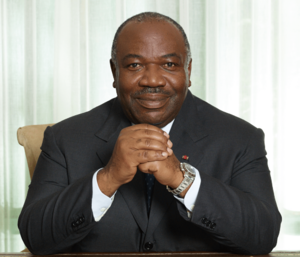
- Pierre Savorgnan de Brazza (1852–1905), the city's founder.
- Antoinette Sassou Nguesso (born 1945), the First Lady of the Republic of the Congo since 1997.
- Ali Bongo Ondimba (born 1959), former President of Gabon.
- Alain Mabanckou (born 1966), a famous novelist, journalist, and poet.
- Cyril Kongo (born 1969), a French painter and graffiti artist who lived in Brazzaville.
- Gaitana (born 1979), a Ukrainian singer who lived in Brazzaville for five years.
Sports Stars from Brazzaville
- François M'Pelé (born 1947), a former footballer.
- Serge Ibaka (born 1989), a professional basketball player.
- Lorène Bazolo (born 1983), a track and field athlete who carried the Congolese flag at the 2012 Summer Olympics.
Sister Cities
Brazzaville has friendly relationships with these cities:
See also
 In Spanish: Brazzaville para niños
In Spanish: Brazzaville para niños


